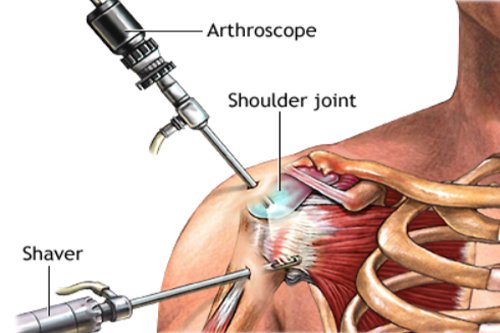Meet Our Doctor
Dr. Vrushabh Kumbhare
Orthopedic and Joint Replacement Surgeon
Educational details:
- M.B.B.S. (4.5 years +1 year Internship): August 2009 - April 2015 N K P Salve institute of medical sciences and research centre, Digdoh hills, Nagpur, Maharashtra (Under Maharashtra University of Health Sciences, Nashik)
- M.S. Orthopedics(3 years): May 2017- August 2020 Jawaharlal Nehru Medical Collage, Sawangi (Meghe) (Under Datta Meghe Institute of Medical Sciences Deemed to be University)
Experience:
- Senior resident: (September 2019 – May 2021) Department of Orthopaedics, Jawaharlal Nehru Medical Collage, Sawangi (Meghe)


Dr. Vrushabh Kumbhare
Orthopedic and Joint Replacement Surgeon
Shoulder Arthroscopy In Nagpur
Shoulder arthroscopy is a minimally invasive surgical procedure use to diagnose and treat various shoulder joint conditions. It involves the use of a small camera, call an arthroscope, which is insert through small incisions around the shoulder. The arthroscope allows the surgeon to visualize the inside of the shoulder joint on a monitor. One of the advantages of shoulder arthroscopy is that it typically involves smaller incisions compared to traditional open surgery. This often results in less pain, quicker recovery, and reduce scarring for the patient. However, not all shoulder conditions can be treat arthroscopically, and the suitability of the procedure depends on the specific diagnosis and individual patient factors.. Feel free to visit our clinic and schedule an appointment.

Why is shoulder surgery done?
Rotator Cuff Tears: The rotator cuff is a group of muscles and tendons that surround the shoulder joint, providing stability and allowing for movement. Tears in the rotator cuff can occur due to injury or degeneration, and surgery may be need to repair the torn tendons.
Labral Tears: The labrum is a rim of cartilage that surrounds the shoulder socket, providing stability to the joint. Tears in the labrum can result from trauma or overuse, and surgical intervention may be necessary to repair or reconstruct the damage labrum.
Shoulder Instability: Dislocations or recurrent subluxations can lead to shoulder instability. Surgery may be performe to tighten and repair the ligaments that support the shoulder joint, reducing the risk of dislocations.
Arthritis: Arthritis can affect the shoulder joint, causing pain and limiting mobility. Surgical options may include joint replacement (arthroplasty) to relieve pain and improve function.
Fractures: Fractures of the shoulder bones, such as the humerus or collarbone, may require surgical intervention to realign the bones and facilitate proper healing.
Impingement Syndrome: Impingement occurs when the rotator cuff tendons become pinch between the bones of the shoulder. Surgery may be need to remove bone spurs or other structures causing impingement.
Frozen Shoulder (Adhesive Capsulitis): In cases of severe frozen shoulder, where conservative treatments have fail, surgery may be considere to release the tight joint capsule and improve range of motion.
Tumor Removal: In rare cases, tumors affecting the bones or soft tissues of the shoulder may necessitate surgery for removal.
Procedure Arthroscopic shoulder surgery
Preoperative Evaluation
- Before the surgery, the patient undergoes a thorough evaluation, which may include physical examinations, imaging studies (such as X-rays or MRI scans), and discussions about medical history and symptoms.
Anesthesia
- Arthroscopic shoulder surgery is usually performed under general anesthesia, meaning the patient is unconscious and feels no pain during the procedure. In some cases, regional anesthesia or a nerve block may be used to numb the shoulder and surrounding area.
Patient Positioning
- Thus, The patient is positioned in a way that provides the surgeon with optimal access to the shoulder joint. This often involves placing the patient in a semi-reclined or lateral decubitus position.
Joint Visualization
- The arthroscope, a thin tube with a light source and camera on the end, is inserted through one of the portals. The camera sends real-time images of the inside of the shoulder joint to a monitor in the operating room, allowing the surgeon to visualize the structures.
Benefits of Arthroscopic Shoulder surgery
Minimally Invasive: Once, Arthroscopy is a minimally invasive procedure, which means it involves small incisions rather than large ones. Therefore, This results in less tissue damage reduced trauma to surrounding structures, and a potentially faster recovery.
Reduced Scarring: The small incisions used in arthroscopy result in smaller scars compared to traditional open surgery. Thus, This is particularly beneficial for individuals who prefer a more cosmetically appealing outcome.
Faster Recovery: Thus, Due to the smaller incisions and reduced tissue trauma, patients often experience a quicker recovery time compared to open surgery. Once, This can lead to a faster return to daily activities and work.
Less Pain: Once, Minimally invasive techniques generally result in less postoperative pain. Patients may require less pain medication, and the overall discomfort during the recovery period may be reduced.
Lower Risk of Infection: With smaller incisions and less exposure of internal tissues to the external environment, the risk of infection is typically lower compared to open surgery.
Quicker Return to Function: Thus, Arthroscopic surgery allows for targeted and precise treatment of specific shoulder issues. This, coupled with the minimally invasive nature, often results in a quicker return to normal shoulder function and range of motion.
Diagnostic and Therapeutic: Arthroscopy is not only a diagnostic tool but also a therapeutic one. Surgeons can visualize the inside of the shoulder joint and simultaneously address issues by performing repairs, reconstructions, or removal of damaged tissue.
